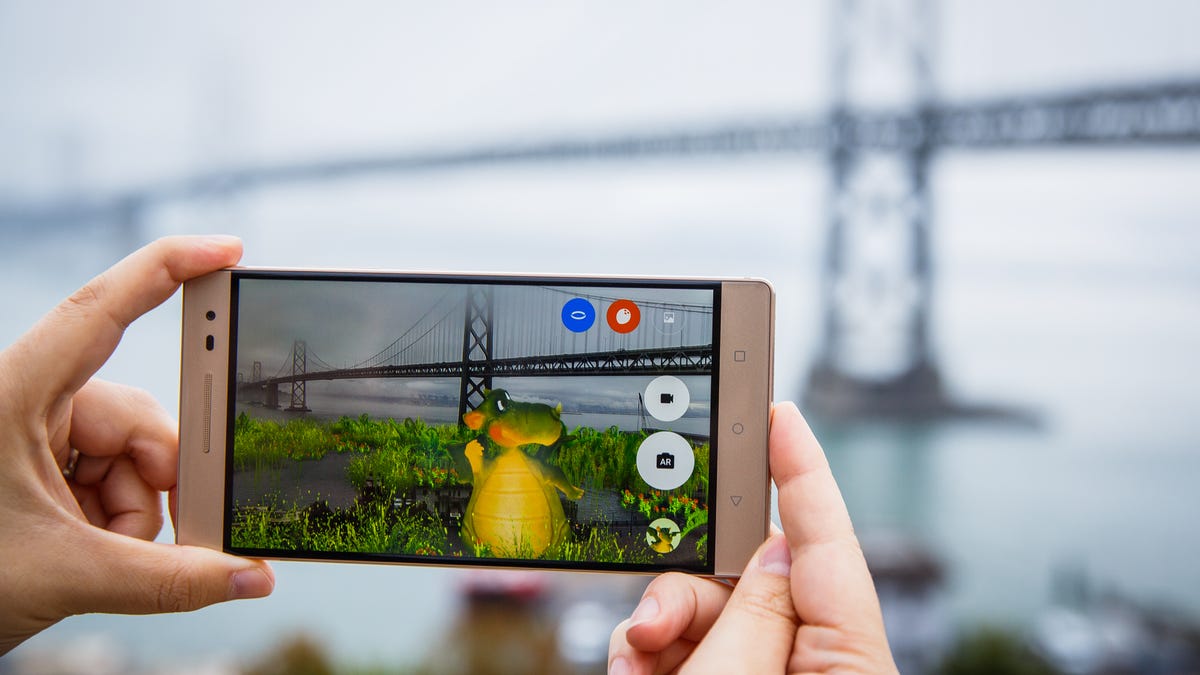ARCore is Google's Tango replacement. Can it catch Apple?
Tango is toast. Here's Google's new plan for AR.
Google pledged last November that Tango, its 3D-sensing camera technology that can measure objects just by looking at them, would be the hottest thing since GPS.
Nikhil Chandhok, Tango's director of product, insisted it wasn't just an experiment. "Many, many phone manufacturers" would build Tango phones in 2017, he said.
Well, guess what? Turns out it was an experiment, one that Google is now killing dead. That's because Apple came up with a better, cheaper way to do practically the same thing. (Read more about that here.)
CNET senior reporter Rich Nieva... and a cartoon lion that doesn't exist. ARCore in action.
Apple's playbook
So now, instead of doggedly trying to convince manufacturers to build thick, battery-unfriendly Tango phones with their own dedicated apps like before, Google is cutting its losses and changing its playbook to match Apple's -- practically word for word.
Apple has ARKit, while Google now has ARCore. Both let developers use the single camera of an existing phone to sense their environment and track your phone's motion relative to the real world. Both sense nearby surfaces like floors and tables so you can "pin" virtual objects to them -- objects only visible through the screen of your phone.
Both adjust lighting on virtual objects to match the real world, too. If, say, there's a Pokemon standing in front of you, you'd see all the shadows pointed in the right direction instead of haphazardly slapped on top.
And both are targeted at developers now, consumers later. They're promising those developers an easy way to create Pokemon Go-like augmented reality apps that can theoretically run on hundreds of millions of existing phones and live in a normal app store.
Google isn't blind. Sure, the company's trying to spin this move as its own idea. (Google told CNET it's been working on Tango-less AR for a while, but waffled when we asked how long.) But Google AR/VR boss Clay Bavor not only admits there are similarities to Apple, he hints that they're intentional.
Google's Clay Bavor, introducing the Daydream View headset in October 2016.
Blocks, a demo that shows off ARCore's basic capability.
"I don't worry a lot about 'first.' I care about there being great things on Android, and having the device capabilities to support them," Bavor tells us. "There's a very high level of comparability, and I think a developer who's built something for ARCore would find it pretty straightforward to bring it to ARKit and vice versa."
In fact, Bavor suggests the similarities could help Google get its own future AR apps onto Apple iPhones, too. "We have Maps everywhere, we have Search everywhere, we have Gmail everywhere. We can only bring the AR experiences we're so excited about to life with a broad device footprint for people to deploy on."
And Google does have a vision that goes beyond what Apple has publicly revealed. In addition to working with big 3D game engines like Unreal and Unity, Google says it's building an experimental web browser where "the webpage can extend into the physical world," where developers can use Java to push 3D objects directly off a web page into the world around you.
The company has grand ambitions for persistent, shared AR experiences too. Bavor imagines adding a layer of digital graffiti to the front of his house, or digital Post-Its so he can tell house guests how to use his "crazy coffeemaker."
Is ARCore as good as ARKit?
While Google's decision to pivot toward Apple's vision makes a whole lot of sense, it may have some catching up to do.
Google's coolest demo: a furniture search based on available space.
In demos, Google's new tech definitely worked -- and quickly, both on a Google Pixel phone with Android Oreo and Samsung's Galaxy S8 with Nougat. Only, it wasn't quite clear how well. Whether I was looking at tiny virtual trees atop a real-world table, watching a giant cartoon bear flexing its muscles or sizing up a coffee table, there were few indications (yet) the software is robust and accurate enough to do the tricks we've seen from Apple's ARKit and from Google's own Tango. (Virtual tape measure, anyone?)
Google couldn't show me a shared AR experience yet, either. That's talk for now.
And while Bavor says ARCore software should run on as many as 100 million Android phones this winter (running Android Nougat and up), that's a heck of a thing to promise given just how many different cameras and software divisions exist among the Android phones in the market.
Bottom line: It's too early to say if ARCore is as good as ARKit, or even good enough. But here's hoping.
Tango's ashes
It's worth noting that -- although Google's focus is no longer on Tango, and Bavor all but admits the ARCore brand will replace it -- the idea of using multiple hardware sensors is still in the cards.
Just this month, Qualcomm , which helped Google build Tango phone reference designs, announced enhanced features designed for depth-sensing cameras as well. Bavor wouldn't comment on Qualcomm's plans, but says ARCore will be designed to use additional hardware sensors whenever possible, possibly including the dual cameras that have been popping up in an increasing number of phones.
"I believe firmly that we're going to see more and more sensing capability on phones over time," he said.
And though you probably shouldn't expect any more Tango phones after Lenovo's Phab 2 Pro and the just-released Asus ZenFone AR, that doesn't mean the team that helped build them has been dismissed. The proof: Nikhil Chandhok, the same Tango director of product who promised "many" Tango phones, the same man leading my demo, is now director of product for ARCore.
The method may have changed, but the dream lives on.


